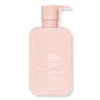What's inside
What's inside
 Key Ingredients
Key Ingredients

 Benefits
Benefits

 Concerns
Concerns

 Ingredients Side-by-side
Ingredients Side-by-side

Water
Skin ConditioningBrassica Alcohol
EmollientAspartic Acid
MaskingBehentrimonium Chloride
PreservativeCetearyl Alcohol
EmollientArgania Spinosa Kernel Oil
EmollientCaprylhydroxamic Acid
Caprylyl Glycol
EmollientGlycerin
HumectantHydrolyzed Pea Protein
EmollientPanthenol
Skin ConditioningPalmitoyl Pea Amino Acids
Skin ConditioningMacadamia Ternifolia Seed Oil
EmollientMoringa Oleifera Seed Extract
Skin ConditioningCitrus Aurantium Sinensis Fiber
Emulsion StabilisingLactic Acid
BufferingMentha Piperita Oil
MaskingEucalyptus Globulus Oil
Xanthan Gum
EmulsifyingChamomilla Recutita Extract
Skin ConditioningMelissa Officinalis Leaf Extract
Skin ConditioningRosmarinus Officinalis Leaf Extract
AntimicrobialSalvia Officinalis Extract
AntimicrobialWater, Brassica Alcohol, Aspartic Acid, Behentrimonium Chloride, Cetearyl Alcohol, Argania Spinosa Kernel Oil, Caprylhydroxamic Acid, Caprylyl Glycol, Glycerin, Hydrolyzed Pea Protein, Panthenol, Palmitoyl Pea Amino Acids, Macadamia Ternifolia Seed Oil, Moringa Oleifera Seed Extract, Citrus Aurantium Sinensis Fiber, Lactic Acid, Mentha Piperita Oil, Eucalyptus Globulus Oil, Xanthan Gum, Chamomilla Recutita Extract, Melissa Officinalis Leaf Extract, Rosmarinus Officinalis Leaf Extract, Salvia Officinalis Extract
Water
Skin ConditioningCetearyl Alcohol
EmollientGlycerin
HumectantBehentrimonium Chloride
PreservativeDimethicone
EmollientDimethiconol
EmollientStearamidopropyl Dimethylamine
EmulsifyingButyrospermum Parkii Butter
Skin ConditioningCocos Nucifera Oil
MaskingPhyllostachys Bambusoides Extract
Skin ConditioningLeuconostoc/Radish Root Ferment Filtrate
AntimicrobialIsopropyl Alcohol
SolventHydroxyethylcellulose
Emulsion StabilisingSalicylic Acid
MaskingDisodium EDTA
Laureth-23
CleansingTea-Dodecylbenzenesulfonate
CleansingCitric Acid
BufferingC12-15 Pareth-3
EmulsifyingCocamidopropyl Betaine
CleansingGuar Hydroxypropyltrimonium Chloride
Skin ConditioningPhenoxyethanol
PreservativeEthylhexylglycerin
Skin ConditioningDisodium Phosphate
BufferingPolysorbate 60
EmulsifyingSodium Phosphate
BufferingParfum
MaskingHexyl Cinnamal
PerfumingLinalool
PerfumingWater, Cetearyl Alcohol, Glycerin, Behentrimonium Chloride, Dimethicone, Dimethiconol, Stearamidopropyl Dimethylamine, Butyrospermum Parkii Butter, Cocos Nucifera Oil, Phyllostachys Bambusoides Extract, Leuconostoc/Radish Root Ferment Filtrate, Isopropyl Alcohol, Hydroxyethylcellulose, Salicylic Acid, Disodium EDTA, Laureth-23, Tea-Dodecylbenzenesulfonate, Citric Acid, C12-15 Pareth-3, Cocamidopropyl Betaine, Guar Hydroxypropyltrimonium Chloride, Phenoxyethanol, Ethylhexylglycerin, Disodium Phosphate, Polysorbate 60, Sodium Phosphate, Parfum, Hexyl Cinnamal, Linalool
Ingredients Explained
These ingredients are found in both products.
Ingredients higher up in an ingredient list are typically present in a larger amount.
This ingredient is a preservative and often used for it's anti-static properties. You'll most likely see this ingredient in hair conditioners.
It does not cause irritation or sensitization in leave-on products at 1-5%.
Cetearyl alcohol is a mixture of two fatty alcohols: cetyl alcohol and stearyl alcohol. It is mainly used as an emulsifier. Emulsifiers help prevent the separation of oils and products. Due to its composition, it can also be used to thicken a product or help create foam.
Cetearyl alcohol is an emollient. Emollients help soothe and hydrate the skin by trapping moisture.
Studies show Cetearyl alcohol is non-toxic and non-irritating. The FDA allows products labeled "alcohol-free" to have fatty alcohols.
This ingredient is usually derived from plant oils such as palm, vegetable, or coconut oils. There is debate on whether this ingredient will cause acne.
Due to the fatty acid base, this ingredient may not be Malassezia folliculitis safe.
Learn more about Cetearyl AlcoholGlycerin is already naturally found in your skin. It helps moisturize and protect your skin.
A study from 2016 found glycerin to be more effective as a humectant than AHAs and hyaluronic acid.
As a humectant, it helps the skin stay hydrated by pulling moisture to your skin. The low molecular weight of glycerin allows it to pull moisture into the deeper layers of your skin.
Hydrated skin improves your skin barrier; Your skin barrier helps protect against irritants and bacteria.
Glycerin has also been found to have antimicrobial and antiviral properties. Due to these properties, glycerin is often used in wound and burn treatments.
In cosmetics, glycerin is usually derived from plants such as soybean or palm. However, it can also be sourced from animals, such as tallow or animal fat.
This ingredient is organic, colorless, odorless, and non-toxic.
Glycerin is the name for this ingredient in American English. British English uses Glycerol/Glycerine.
Learn more about GlycerinWater. It's the most common cosmetic ingredient of all. You'll usually see it at the top of ingredient lists, meaning that it makes up the largest part of the product.
So why is it so popular? Water most often acts as a solvent - this means that it helps dissolve other ingredients into the formulation.
You'll also recognize water as that liquid we all need to stay alive. If you see this, drink a glass of water. Stay hydrated!
Learn more about Water